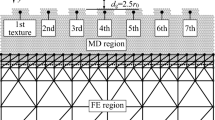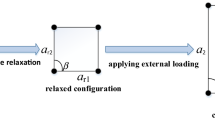Abstract
The feasibility of reducing contact resistance by adding nano-textures on the contact surface is evaluated by three-dimensional simulation. Upward and downward pyramids and hemispheres are considered, and the effects of contact area and electric field are discussed. The downward nano-texture has a stronger electric field than the upward nano-texture; thus the increasing contact area will be more effectively used and lead to a greater improvement effect. On the other hand, the electric field of the hemisphere nano-texture is lower than that of the pyramid nano-texture. With proper design, the nano-textured contact can effectively reduce contact resistance up to 30–50%. Therefore, the proposed nano-textured contact is a promising approach with contact resistivity approaching physical limits.
Similar content being viewed by others
References
G.E. Moore, Electronics 38, 8 (1965).
H. Wu, O. Gluschenkov, G. Tsutsui, C. Niu, K. Brew, C. Durfee, C. Prindle, V. Kamineni, S. Mochizuki, and C. Lavoie, in IEDM (2018), pp. 819–822.
A. Agrawal, J. Lin, M. Barth, R. White, B. Zheng, S. Chopra, S. Gupta, K. Wang, J. Gelatos, and S.E. Mohney, Appl. Phys. 104, 11 (2014).
F. Padovani and R. Stratton, Solid State Electron. 9, 7 (1966).
C. Crowell and V. Rideout, Solid State Electron. 12, 2 (1969).
B. Downey, S. Datta, and S.E. Mohney, Semicond. Sci. Technol. 25, 1 (2009).
H. Yu, M. Schaekers, E. Rosseel, A. Peter, J.-G. Lee, W.-B. Song, S. Demuynck, T. Chiarella, J.-Å. Ragnarsson, and S. Kubicek, in IEDM (2015), pp. 592–595.
H. Yu, M. Schaekers, A. Peter, G. Pourtois, E. Rosseel, J.-G. Lee, W.-B. Song, K.M. Shin, J.-L. Everaert, and S.A. Chew, IEEE Trans. Electron Devices 63, 12 (2016).
C.-N. Ni, X. Li, S. Sharma, K. Rao, M. Jin, C. Lazik, V. Banthia, B. Colombeau, N. Variam, and A. Mayur, in VLSI Technology (2015), pp. T118–T119.
R. Kim, U.E. Avci, and I.A. Young, IEEE Trans. Electron Devices 66, 3 (2019).
Y. Wu, H. Xu, L.-H. Chua, K. Han, W. Zou, T. Henry, J. Zhang, C. Wang, C. Sun, and X. Gong, in VLSI Technology (2019), pp. T150–T151.
Y. Wu, W. Wang, S. Masudy-Panah, Y. Li, K. Han, L. He, Z. Zhang, D. Lei, S. Xu, and Y. Kang, in VLSI Technology (2018), pp. 77–78.
H. Niimi, Z. Liu, O. Gluschenkov, S. Mochizuki, J. Fronheiser, J. Li, J. Demarest, C. Zhang, B. Liu, J. Yang, M. Raymond, B. Haran, H. Bu, and T. Yamashita, IEEE Electron Device Lett. 37, 11 (2016).
H. Seidel, L. Csepregi, A. Heuberger, and H. Baumgärtel, J. Electrochem. Soc. 137, 11 (1990).
C.-T. Seo, C.-H. Bae, D.-S. Eun, J.-K. Shin, and J.-H. Lee, Jpn. J. Appl. Phys. 43, 11R (2004).
A.K. Mallik, G. Peterson, and M.H. Weichold, J. Microelectromech. Syst. 4, 3 (1995).
TCAD Sentaurus Tutorial. (Synopsys, Inc., Mountain View, CA, 2016)
Acknowledgments
This work was financially supported by the Center for Semiconductor Technology Research from The Featured Areas Research Center Program within the framework of the Higher Education Sprout Project by the Ministry of Education (MOE) in Taiwan, R.O.C., and was also supported in part by the Ministry of Science and Technology, Taiwan, R.O.C. under Grant 108-2633-E-009-001. The authors thank Prof. Chenming Hu for his initial suggestions and helpful discussion.
Author information
Authors and Affiliations
Corresponding author
Additional information
Publisher's Note
Springer Nature remains neutral with regard to jurisdictional claims in published maps and institutional affiliations.
Rights and permissions
About this article
Cite this article
Tsui, BY., Lee, YH. & Lee, CY. Reduction of Contact Resistivity by Nano-Textured Contact. J. Electron. Mater. 49, 6783–6788 (2020). https://doi.org/10.1007/s11664-020-08236-1
Received:
Accepted:
Published:
Issue Date:
DOI: https://doi.org/10.1007/s11664-020-08236-1




